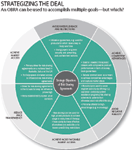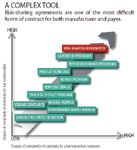Pay For Play
The P4P movement is here. Pharma marketers, it's time to take note.
In the turbulent world of healthcare reform, there's a lot of disagreement on the best way to eliminate unnecessary costs while preserving quality of care. But on one point, most stakeholders agree: Any effective solution will almost certainly involve realignment of financial incentives to guarantee rewards for disease-management efforts that result in high quality care.
That is the idea behind the growing "pay for performance" (P4P) movement, which rewards physicians, hospitals, and other caregivers for meeting quality metrics—hitting a target percentage of patients screened for a particular condition, for example, or adopting the use of information technology.
It's also the idea behind outcomes-based risk-sharing agreements (OBRAs), an emerging technique that could ultimately have a major impact on pharmaceutical contracting and pricing. These agreements come in various types, but they are generally contracts between payers and manufacturers that factor patient outcomes into pricing and other terms. For example:
» Requiring the payer to reimburse only when the drug actually makes the patient better
» Setting price according to how well patients hit targets such as blood pressure or cholesterol level
» Having the pharmaceutical company pay for treatment if the drug fails to prevent a negative outcome
Outcomes-based risk-sharing agreements are still fairly rare in the United States, but they have become a standard feature of European negotiations over market access, and a few recent US deals have pointed out the potential the technique has even in dealing with private-sector payers. It is time for US pharma marketers to prepare for the next curveball the market threatens to throw their way.

STRATEGIZING THE DEAL: An OBRA can be used to accomplish multiple goals-but which?
The European Experience
It is no surprise that OBRAs first came of age in Europe—if only because the healthcare systems there have a centralized payer and policymaking entity (i.e. the government) with a mandate to control healthcare spending. Existing programs in Europe typically focus on high-cost drug therapies for cancer, multiple sclerosis, rheumatoid arthritis, wet AMD, and the like. Prescriptions for these medicines cost from $1,500 up to $100,000 a year. In some countries, especially the UK and Italy, OBRAs have become an important element in gaining market access.
The UK can be a particularly precarious reimbursement environment for high-cost specialty drugs. Merck KGaA's Erbitux and Roche/Genentech's Avastin, both oncology drugs, and Wyeth's and Bayer-Schering's kidney cancer drugs Torisel and Nexavar were all denied reimbursement in the UK because they fell beneath the cost-effectiveness threshold set by the National Institute for Health and Clinical Excellence (NICE).
When a similar fate befell the MS drugs Copaxone (glatiramer), Avonex, Betaferon, and Rebif (all three forms of beta interferon) in 2002, the manufacturers (Teva, Biogen, Schering AG, and Serono, respectively) struck deals for a 10-year experimental OBRA with the UK's National Health Service (NHS).
Under the terms of the agreement, patients meeting certain criteria could receive one of the drugs. They would be assessed periodically against target treatment outcomes, and the price was to be adjusted so that NHS paid no more than 36,000 GBP per quality-adjusted life year (QALY).
The MS deal drew considerable criticism, but the underlying principle that drug costs should be tied to outcomes has continued to inspire a great deal of experimentation. Here are several examples of other innovative pricing approaches adopted in Europe to address payer concerns about drugs' uncertain clinical outcomes or unpredictable financial burden:
Full or partial refund for non-responders In 2007, after NICE determined that Janssen-Cilag's myeloma drug Velcade (bortezomib) didn't meet cost-effectiveness criteria, the company proposed a risk-sharing arrangement. The deal permits certain patients with progressive multiple myeloma to use Velcade. After four cycles of therapy, response to treatment is measured using serum-M protein. If the protein is reduced by at least 50 percent, NHS continues to fund treatment. If not, therapy is stopped, and Jannsen-Cilag refunds the cost of the drug already administered.
Initial discounts with outcomes tracking In Italy, Bayer-Schering and Pfizer entered into an agreement that offered the country's health service a 50 percent discount for their oncology drugs Nexavar and Sutent for the first two and three months of use, respectively. At the end of this initial period, treatment continues only for patients who respond, and the discount ends. This initial discount program, with clinical outcomes tracking, ensures drug use in the appropriate patient population where an effective pre-treatment biomarker is not available. At the same time, programs such as this limit payers' financial burden during the treatment phase, when responders are still being identified.
Capitation or initial discounts with outcomes tracking GSK's breast cancer therapy Tykerb, another NICE reject, didn't lend itself to a biomarker-based approach like Velcade. Given the difficulty of linking the individual patient's response to the price of the drug, GSK instead proposed a "cost-cap" program, offering to charge NHS a fixed annual price for Tykerb no matter how many patients use it. Despite being flexible in their subsequent pricing structure by offering to bear the cost of Tykerb for the first 12 weeks of treatment—with NHS then only paying for patients who continue to receive clinical benefit—Tykerb is still not recommended by NICE for routine use by women with advanced breast cancer.

A COMPLEX TOOL: Risk-sharing agreements are one of the most difficult forms of contract for both manufacturer and payer.
US Experiments
There are many reasons why outcomes-based risk sharing has been slower to develop in the United States—not least among them the fact that there is no single central health system to negotiate with. Until recently, most risk-sharing deals took the form of money back guarantees used to gain first mover advantage and build market share. Examples include Proscar (Merck-Frost) in 1994, Clozaril (Sandoz) in 1995, Zocor (Merck) in 1998, and Diovan (Novartis) and Cialis (Lilly/ICOS), both in 2004. Key differences between these arrangements and those in Europe include that these were used for highly competitive therapeutic classes, they were primarily targeted toward patients (e.g., copay refunds), and there was extensive experience with regard to clinical efficacy of the products.
But there are signs that the US market is moving toward more sophisticated risk-sharing agreements. The past few months have seen the announcement of several agreements that adapt the technique to the needs of a system dominated by private-sector payers.
In April, Procter & Gamble and Sanofi-Aventis announced the launch of a pilot program with Health Alliance, a small Midwestern insurer, covering the anti-osteoporosis drug Actonel. Under the arrangement, the manufacturers promise to reimburse Health Alliance's average treatment costs for certain bone fractures suffered by women in the plan who have been taking Actonel correctly for at least six months.
Just weeks later, Merck and the insurance company Cigna announced an innovative deal covering Merck's diabetes drugs Januvia and Janumet. Where most performance-based arrangements pay the drug company more for a more effective drug, this deal took the opposite approach, calculated to drive patient adherence and volume. Cigna will review A1C lab values for its patients who take any oral anti-diabetic drugs, not just Merck's. If the A1C values improve over the course of a year, Cigna gets a bigger discount on Januvia and Janumet. If claims data show that patients who have been prescribed Januvia or Janumet are taking the drugs as prescribed, the discount increases. The deal suggests the shape that performance-based risk sharing may take in this country—providing financial incentives to payers to treat patients better and focus on results.
Barriers to Implementation
OBRAs can provide manufacturers with an effective market-access tool. They can also provide payers with a strong tool in their quest to extract greater value from money spent in high cost therapeutic areas. But OBRAs can be extremely complex, especially when compared to other types of contracts such as straight net-price reductions, volume discounts, access rebates, and capitation programs. Both payers and manufacturers must consider the critical issues surrounding implementation to ensure that the objectives of both parties are reached in the end.
The key issues to be considered include:
Market characteristics Single-payer markets, such as those of the EU, are better positioned to implement OBRAs, because manufacturers generally need to work with a single entity—the government or central health authorities. The US market, by contrast, includes numerous different payers and other stakeholders. Full-scale market penetration in the US would require negotiating agreements by payer, by state/region, and by drug or condition, and would demand significant internal personnel resources from both manufacturers and the aggregate US system. As the US healthcare system becomes more "networked," this issue could be mitigated. But the system will likely remain quite decentralized for years to come.
Infrastructure The most challenging operational barrier to widespread implementation of OBRAs in the US is having the clinical and information technology infrastructure to support successful implementation of the programs. Because risk-sharing agreements nearly always include clinical outcome end points, systems must be able not only to record and store clinical information, but also to accurately, reliably, and comprehensively report it.
This issue is exacerbated in the highly fragmented and decentralized US healthcare system, where many payer IT systems are outdated, inflexible, payment-focused (i.e., claims-based, with little clinical focus), or otherwise not built to track and report clinical quality data. As payers continue to upgrade their information systems and functionality improvements occur, these issues will likely be alleviated.
Deal structure As the examples above make clear, there are many, many questions to answer in structuring an OBRA. For instance: Will the agreement include a rebate from the manufacturer or a future payment from the payer once treatment effectiveness has been determined?
The direct and indirect financial impact of deal terms become particularly relevant if the rebate or payment owed is substantial. The direct impact relates to the time value of money—if a rebate or payment that totals in the tens of millions of dollars does not reach the recipient's bank account for a year (or more), that money has lost value. The indirect impact is the opportunity cost of not having those funds available to invest in positive net present value (NPV) projects that could be near or already providing financial returns by the time the transaction occurs.
Finding the Strategy That Works
Underlying all these implementation issues is a more fundamental question for pharmaceutical companies: How does the use of OBRAs further one or more of the company's strategic objectives? A specific question in this area is whether the company should focus on more competitive markets (e.g., statins) or if its comparative advantage lies within niche markets with specialty products. Do risk-sharing agreements help achieve more favorable market access or competitive advantages? What is out there to be gained for a pharmaceutical company or can one only lose when using this innovative contracting approach? What is the theoretic danger of spill-over effects to other therapeutic areas or other product classes a company markets? How does the company respond when a competitor with a product of similar clinical profile and efficacy, even in an area of high unmet clinical need, enters into an OBRA with a prominent US payer such as CMS, or a large private payer such as Aetna?
While US market access for expensive pharmaceuticals is currently quite liberal, payers insinuate that the current environment will not continue for long. As the quality-based US P4P programs have shown, significant operational barriers can be overcome and more widespread use of these programs can occur. Pharmaceutical companies should therefore not be complacent, even with the likely scenario that the use of OBRAs will not become widespread in the US for a number of years. In fact, companies should begin integrating discussions of this tool into strategic decision-making to ensure they can quickly and effectively respond to competitor actions if (or when) OBRAs take hold and make financial sense. A deeply analytical approach is needed to ensure that the manufacturers are properly positioned to respond to future competitive dynamics in the marketplace.
Although the outcomes-based risk-sharing movement in the US is in its infancy, it is nonetheless making inroads into the way healthcare organizations do business. Payers will undoubtedly continue to exert their influence in the market and strengthen their cost-cutting toolkit as costs continue to rise unsustainably. It therefore behooves manufacturers to think about how to position themselves and their product-development processes to best meet the operational, clinical, financial, and marketing challenges these arrangements will entail.
Christian Schuler is a partner at the consultancy Simon-Kucher & Partners. He can be reached at Christian.Schuler@simon-kucher.com. Laronne P. Faulker, formerly an intern with the firm, is currently studying in Spain. He can be reached at laronne@stanfordalumni.org

The Misinformation Maze: Navigating Public Health in the Digital Age
March 11th 2025Jennifer Butler, chief commercial officer of Pleio, discusses misinformation's threat to public health, where patients are turning for trustworthy health information, the industry's pivot to peer-to-patient strategies to educate patients, and more.
Navigating Distrust: Pharma in the Age of Social Media
February 18th 2025Ian Baer, Founder and CEO of Sooth, discusses how the growing distrust in social media will impact industry marketing strategies and the relationships between pharmaceutical companies and the patients they aim to serve. He also explains dark social, how to combat misinformation, closing the trust gap, and more.